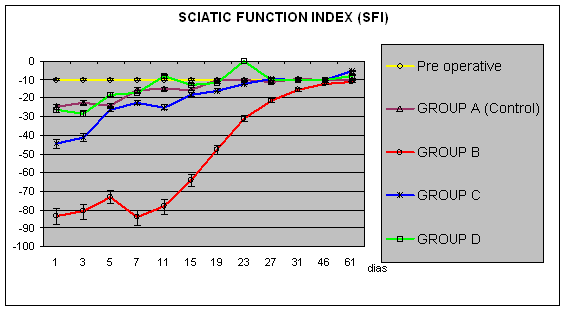Sunday, October 10, 2004
6335
Intraneural Haematoma with Extrinsic Compression: Experimental Study in Rats and Therapeutic Options
INTRANEURAL HAEMATOMA WITH EXTRINSIC COMPRESSION: EXPERIMENTAL STUDY IN RATS AND THERAPEUTIC OPTIONS
Introduction: An intraneural haematoma in median nerve at carpal tunnel can result after trauma or in relation to clotting disturbances. The decision for clinical observation or descompressive surgical thecniques is still controversial. The authors developed an experimental study in sciatic nerves of rats to simulate a carpal tunnel and study the effects of intraneural haematoma and to analyse the results of the surgical treatment. Materials and methods: Forty male rats Wistar were divided in 4 groups. The sciatic nerve were covered with a silastic device, like the median nerve through the flexor retinaculum. In the group A (CONTROL) the right sciatic nerve was just covered by the silastic. In group B, the right sciatic nerves were wrapped by silastic tubes of larger internal diameter than the one of the nerve, and produced haematoma in the wrapped up segment with intraneural injection of 0,2 ml of autologous blood. In group C , after haematoma we have removed the silastic device and performed an epineurotomy. In group D, we just have removed the silastic device after the haematoma. Recovering of nerve function was analysed for 61 days by the walking track and sciatic function index (SFI) of Bain-Mackinnon-Hunter. The SFI varies from 0 to -100, and zero is the normal function of nerve and -100 is total loss of function. At the end of the study we have performed a histological assessment of the nerves in the middle point to compressive site. Results: Group A ( control) presented function deficit of 21% (SFI=-21) and returned to initial values at third post operative day. Group B ( haematoma and extrinsic compression ) exhibited the worst function ( SFI= - 83) after surgery and has recovered in 23 days. Group C ( remove of silastic band and epineurotomy) had 44% of function loss (SFI = -44) and it became normal at 5 th post operative day. Group D (just remove of silastic device) presented SFI -26 and it was recovered at fifth post operative day. Statistic data of SFI exhibited differences between expectant option versus descompressives procedures (p<0,001). Conclusion : The intraneural haematoma with extrinsic compression provokes functional deficit with recovery of the function in 23 days. Surgical treatment by the remove of the compression presents fast functional recovery in 5 days. Epineurotomy associated to descompressive surgery showed functional gain in relation to conservative procedure and so fast as extrinsic compression removal isolated.
View Synopsis (.doc format, 51.0 kb)

